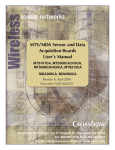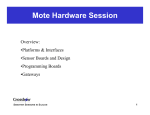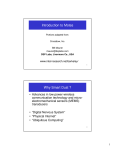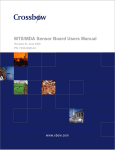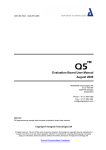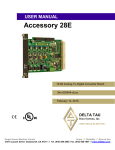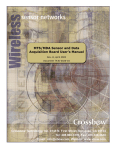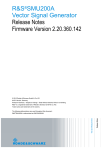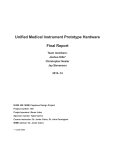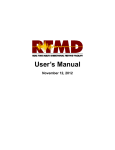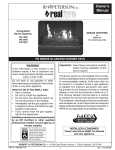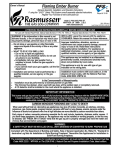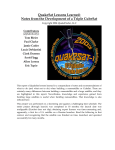Download MTS/MDA Sensor and Data Acquisition Boards User`s Manual
Transcript
MTS/MDA Sensor and Data Acquisition Boards User’s Manual MTS101CA, MTS300CA, MTS310CA Rev. A, April 2003 Document 7430-0020-01 Crossbow Technology, Inc., 41 Daggett Dr., San Jose, CA 95134 Tel: 408-965-3300, Fax: 408-324-4840 email: [email protected], website: www.xbow.com ©2002-2003 Crossbow Technology, Inc. All rights reserved. Information in this document is subject to change without notice. Crossbow and SoftSensor are registered trademarks and DMU is a trademark of Crossbow Technology, Inc. Other product and trade names are trademarks or registered trademarks of their respective holders. MTS/MDA Sensor Board User’s Manual 1 Introduction.........................................................................2 2 MTS101CA..........................................................................3 3 4 2.1 2.2 2.3 Thermistor................................................................................................3 Conversion to Engineering Units .........................................................4 Light Sensor.............................................................................................5 2.4 Prototyping Area.....................................................................................5 MTS300CA / MTS310CA.....................................................8 3.1 3.2 Microphone..............................................................................................8 Sounder.....................................................................................................9 3.3 3.4 3.5 Light and Temperature ...........................................................................9 2-Axis Accelerometer (MTS310CA Only).......................................10 2-Axis Magnetometer (MTS310CA Only).......................................10 3.6 3.7 Turning Sensors On and Off ...............................................................11 Schematic of the MTS300CA and MTS310CA ..............................12 MDA500CA .......................................................................18 4.1 5 TinyOS...............................................................................19 5.1 6 Schematic ...............................................................................................18 Building TinyOS Code with Sensor Board.......................................19 Appendix D. Warranty and Support Information..............20 6.1 6.2 6.3 6.3.1 6.3.2 6.3.3 6.3.4 6.3.5 6.4 Customer Service ..................................................................................20 Contact Directory ..................................................................................20 Return Procedure...................................................................................20 Authorization ...................................................................................20 Identification and Protection...........................................................21 Sealing the Container ......................................................................21 Marking...........................................................................................21 Return Shipping Address.................................................................21 Warranty.................................................................................................21 Doc. # 7430-0020-01 Rev. A Page 1 MTS/MDA Sensor Board User’s Manual 1 Introduction The MTS Series of Sensor Boards are designed to interface with Crossbow’s MICA, MICA2, and MICA2DOT family of wireless motes. There are a variety of sensor boards available, and the sensor boards are specific to the MICA, MICA2 board or the MICA2DOT form factor. The sensor boards allow for a range of different sensing modalities as well as interface to external sensor via prototyping areas or screw terminals. The following table lists the currently available sensor boards for each mote family. Part Number Mote Support Sensors MTS101CA MICA, MICA2 Light, Temperature, Prototype Area MTS300CA MICA, MICA2 Light, Temperature, Acoustic, and Sounder MTS310CA MICA, MICA2 Light, Temperature, Acoustic, Sounder, 2-Axis Accelerometer (ADXL202), and 2-Axis Magnetometer MDA500CA MICA2DOT General Purpose Interface Page 2 Doc. # 7430-0020-01 Rev. A MTS/MDA Sensor Board User’s Manual 2 MTS101CA The MTS101CA series sensor boards have a precision thermistor, a light sensor/photocell, and general prototyping area. The prototyping area supports connection to five channels of the Mote’s A-D Converter (ADC37) and the I2C digital communications bus. The prototyping area also has 24 unconnected holes that are used for breadboard of circuitry. 2.1 Thermistor The Thermistor, (YSI 44006, http://www.ysi.com) sensor is a highly accurate and highly stable sensor element. With proper calibration, an accuracy of 0.2°C can be achieved. The Thermistor resistance varies with temperature (see Table and Graph). This curve, although non-linear, is very repeatable. The sensor is connected to the analog-digital converter channel number 5 (ADC5, U1 pin 38) thru a basic resistor divider circuit. In order to use the thermistor, the sensor must be enabled by setting digital control line PW2 high. See circuit below. PW2 RT1 Thermistor ADC5 R3 10K, 5% gnd_analog Thermistor Specifications: Type: YSI 44006 Time Constant: 10 seconds, Still Air Base Resistance: 10Kohm, @ 25°C Repeatability: Doc. # 7430-0020-01 Rev. A 0.2°C Page 3 MTS/MDA Sensor Board User’s Manual Voltage, Resistance vs. Temperature: Example Temperature (°C) Resistance (Ohms) ADC5 Reading (% of VCC) -40 239,800 4% -20 78,910 11% 0 29,940 25% 25 10,000 50% 40 5592 64% 60 2760 78% 70 1990 83% Resistance vs. Temperature Graph: Resistance (RT1 Ohms) 300,000 250,000 200,000 150,000 100,000 50,000 0 -60 -40 -20 0 20 40 60 80 100 120 Temperature (Deg. C) 2.2 Conversion to Engineering Units The mote’s adc output can be converted to degrees Kelvin using the following approximation over 0-50 degrees C: 1/T(K) = a + b*Ln(Rthr) + c*[Ln(Rthr)]^3 where: Rthr = R1(ADC_FS-ADC)/ADC a = 0.001010024 b = 0.000242127 c = 0.000000146 R1 = 10K ADC_FS = 1024 Page 4 Doc. # 7430-0020-01 Rev. A MTS/MDA Sensor Board User’s Manual ADC = output value from mote’s ADC measurement. 2.3 Light Sensor The light sensor (Clairex CL94L, http://www.clairex.com) is a simple CdSe photocell. The maximum sensitivity of the photocell is at the light wavelength of 690 nm. Typical on resistance, while exposed to light, is 2Kohm. Typical off resistance, while in dark conditions, is 520Kohm. In order to use the light sensor, digital control signal PW1 must be turned on. The output of the sensor is connected to the analog-digital converter channel 6 (ADC6, U1 Pin 37). See Circuit Below. Light Sensor Specifications: Type: Clairex CL94L Ron: 2 Kohm Roff: 520 Kohm PW1 R2 Photoresistor ADC6 R1 10K, 5% gnd_analog 2.4 Prototyping Area The prototyping area is a series of solder holes and connection points for connecting other sensors and devices to the Mote. The prototyping area layout is shown in the diagram and tables below. Doc. # 7430-0020-01 Rev. A Page 5 MTS/MDA Sensor Board User’s Manual abcde U1 1 26 1 2 3 4 5 6 7 8 9 10 11 12 27 51 Thermistor (RT1) Light Sensor (R2) abcde Connection Table (Top View of PCBA) A1-A12 No Connect, Bare Hole C1-C12 No Connect, Bare Hole B1 PW4 (U1-33) B9 I2C_BUS_DATA (U1-22) B2 PW5 (U1-34) B10 I2C_BUS_CLK (U1-21) B3 PW6 (U1-35) B11 FLASH_SO (U1-19) B4 ADC3 (U1-36) B12 FLASH_SI (U1-20) D1 GND_ANALOG (U1-1) D9 GND (U1-51) D2 VDD_ANALOG (U1-2) D10 VCC (U1-50) D3 ADC1 (U1-42) D11 No Connect, Bare Hole D4 ADC2 (U1-41) D12 No Connect, Bare Hole E9 PW3 (U1-32) E11 ADC0 (U1-43) E10 ADC4 (U1-39) E12 GND_ANALOG (U1-1) Page 6 Doc. # 7430-0020-01 Rev. A MTS/MDA Sensor Board User’s Manual X NOTE If you have downloaded the pdf schematic of the Rene basic sensor board from UC Berkeley, you will note that the A/D channels appear in reverse order. This is due to a difference in wiring between the original Rene Mote and the MICA/MICA2 family of motes. M WARNING Never connect signals that are greater than VCC (3V typical) or less than 0V to any of the holes that connect to the Mote Processor Radio board. It is okay to connect different voltages to the non-connected holes. However, be careful. If a voltage out of the range of 0-VCC should reach the Mote Processor Radio Board damage will occur. Doc. # 7430-0020-01 Rev. A Page 7 MTS/MDA Sensor Board User’s Manual 3 MTS300CA / MTS310CA The MTS300CA and MTS310CA .are flexible sensor boards with a variety of sensing modalities. These modalities can be exploited in developing sensor networks for a variety of applications including vehicle detection, low-performance seismic sensing, movement, acoustic ranging, robotics, and other applications. The following section of the user’s manual describes the sensor circuits and general application. Please refer to the schematic diagram at end of section for exact circuit details. 3.1 Microphone The microphone circuit has two principal uses. The first use is for acoustic ranging. The second use is for general acoustic recording and measurement. The basic circuit consists of a pre-amplifier (U1A-1), second-stage amplified with a digital-pot control (U1A, PT2). This circuit amplifies the low-level microphone output. This output can be fed directly into the analog-digital converter (ADC2) by using the Microphone Output selector circuit (MX1) to connect mic_out signal toe ADC2 signal. This configuration is useful for general acoustic recording and measurement. Audio files have been recorded into the Logger Flash memory of MICA, MICA2 Motes for later download and entertainment (or analysis!). The second stage output (mic_out) is routed thru an active filter (U2) and then into a tone detector (TD1). The LM567 CMOS Tone Detector IC actually turns the analog microphone signal into a digital high or low level output at INT3 when a 4KHz tone is present. This tone can be generated by the Sounder circuit on the sensor board. A novel application of the sounder and tone detector is acoustic ranging. In this application, a mote pulses the sounder and sends an RF packet via radio at the same time. A second mote listens for the RF packet and notes the time of arrival by resetting a timer/counter on its processor. It then increments a counter until the tone detector detects the sounder. The counter value is the Time-of-Flight of the sound wave between the two motes. The Time -of-Flight value can be converted into an approximate distance between motes. Using groups of Motes with Sounders and Microphones, a crude localization and positioning system can be built X NOTE Motes are designed for power efficiency. Hence all the sensors are disconnected from power on the MTS300 and MTS310 sensor boards unless specifically turned on. See section 3.6 for more information. Page 8 Doc. # 7430-0020-01 Rev. A MTS/MDA Sensor Board User’s Manual 3.2 Sounder The sounder is a simple 4KHz fixed frequency piezoelectric resonator. The drive and frequency control circuitry is built into the sounder. The only signal required to turn the sounder on and off, is Sounder_Power. Sounder_Power is controlled thru the power control switch (P1) and is set by the hardware line PW2. 3.3 Light and Temperature As on the MTS101CA, the MTS300CA and MTS310CA have a light sensor and a thermistor. The thermistor (Panasonic ERT -J1VR103J) on the MTS300CA and MTS310CA is a surface mount component installed at location RT2. It is configured in a simple voltage divider circuit with a nominal mid-scale reading at 25°C. The output of the temperature sensor circuit is available at ADC1. Power is controlled by setting signal INT2. Voltage, Resistance vs. Temperature: Example Temperature (°C) Resistance (Ohms) ADC1 Reading (% of VCC) -40 427,910 2.3% -20 114,200 8.1% 0 35,670 22% 25 10,000 50% 40 4090 71% 60 2224 82% 70 1520 87% The light sensor (Clairex CL94L, http://www.clairex.com) is a simple CdSe photocell. The maximum sensitivity of the photocell is at the light wavelength of 690 nm. Typical on resistance, while exposed to light, is 2Kohm. Typical off resistance, while in dark conditions, is 520Kohm. In order to use the light sensor, digital control signal PW1 must be turned on. The output of the sensor is connected to the analog-digital converter channel 1 (ADC1). When there is light, the nominal circuit output is near VCC or full-scale, and when it is dark the nominal output is near GND or zero. Power is controlled to the light sensor by setting signal INT1. Doc. # 7430-0020-01 Rev. A Page 9 MTS/MDA Sensor Board User’s Manual X NOTE The light and temperature sensor share the same A/D converter channel (ADC1). Only turn one sensor on at a time, or the reading at ADC1 will be corrupted and meaningless. 3.4 2-Axis Accelerometer (MTS310CA Only) The accelerometer is a MEMS surface micro-machined 2-axis, +/-2G device. It features very low current draw (<1mA) and 10-bit resolution. The sensor can be used for tilt detection, movement, vibration, and/or seismic measurement. The accelerometer, located at U5, is the ADXL202JE and the full datasheet is available at www.analog.com. A summary specification is provided for reference Channels: X (ADC3), Y (ADC4) G-Range: Bandwidth Resolution: +/- 2G (1G = 9.8m/s 2 ) DC-50Hz (controlled by C20, C21) 2mG (0.002G) RMS Sensitivity: Offset: 167 mV/G +/- 17% 2.5 V +/- 0.4V X NOTE The ADXL202 sensitivity and offset have a wide initial tolerance. A simple calibration using earth’s gravitational field can greatly enhance the accuracy of the ADXL202 sensor. By rotating the sensor into a +1G and a –1G position, the offset and sensitivity can be calculated to within 1%. 3.5 2-Axis Magnetometer (MTS310CA Only) The magnetometer circuit is a silicon sensor that has a unique bridge resistor coated in a highly sensitive NiFe coating. This NiFe coating causes the bridge resistance of the circuit to change. The bridge is highly sensitive and can measure the Earth’s field and other small magnetic fields. A useful applications is vehicle detection. Successful test have detected disturbances from automobiles at a radius of 15 feet. The sensor is the Honeywell HMC1002 sensor. A detailed specification sheet is found at www.ssec.honeywell.com. The output of each axis (X, Y) is amplified by an instrumentation amplifier U6, U7. The amplified output is available at ADC5 and ADC6. Each instrumentation amplifier (U6, U7) can be tuned using the digital potentiometer PT1 that is controlled via the I2C bus. Page 10 Doc. # 7430-0020-01 Rev. A MTS/MDA Sensor Board User’s Manual NOTE The NiFe core of the magnetic sensor is extremely sensitive. However, it is also subject to saturation. Saturation occurs when the sensor is exposed to a large magnetic field. Unfortunately the MTS310 circuit does not have an automatic saturation recovery circuit (set/reset). This limitation prevents the magnetometer from being useful in applications requiring DC response (for example compassing). There are four pads label S/R (Set/Reset) available on the PCB for adding an external set/reset circuit. 3.6 Turning Sensors On and Off All of the sensors have a power control circuit. The default condition for the sensor is off. This design helps minimize power draw by the sensor board. In order to turn sensors on, control signals are issued to the power switches. The following table lists the control settings Sensor/Actuator Control Signal Sounder PW2 Microphone PW3 Accelerometer PW4 Magnetometer PW5 Temperature (RT2) INT2 Photocell (R2) INT1 Note only one of the INT1 and INT2 signals should be activated at a time. See Section 3.3 Doc. # 7430-0020-01 Rev. A Page 11 MTS/MDA Sensor Board User’s Manual Schematic of the MTS300CA and MTS310CA Pin 52 Pin 53 U0 Connector (Top) 52 53 3.7 gnd_analog 1 VDD_ANALOG 2 Pin 1 INT3 3 Pin 2 INT2 4 Pin 3 INT1 5 Pin 4 INT0 6 Pin 5 DC_BOOST_SHUTDOWN 7 Pin 6 LED3 8 Pin 7 LED2 9 Pin 8 LED1 10 Pin 9 RD 11 Pin 10 WR 12 Pin 11 ALE 13 Pin 12 PW7 14 Pin 13 FLASH_CLK 15 Pin 14 PROG_MOSI_SPI 16 Pin 15 PROG_MISO_SPI 17 Pin 16 SCK_SPI 18 Pin 17 FLASH_SO 19 Pin 18 FLASH_SI 20 Pin 19 I2C_BUS_1_CLK 21 Pin 20 I2C_BUS_1_DATA 22 Pin 21 PWM0 23 Pin 22 PWM1A 24 Pin 23 AC+ 25 Pin 24 AC26 Pin 25 Pin 26 Pin 27 Pin 28 Pin 29 Pin 30 Pin 31 Pin 32 Pin 33 Pin 34 Pin 35 Pin 36 Pin 37 Pin 38 Pin 39 Pin 40 Pin 41 Pin 42 Pin 43 Pin 44 Pin 45 Pin 46 Pin 47 Pin 48 Pin 49 Pin 50 Pin 51 27 28 29 30 31 32 33 34 35 36 37 38 39 40 41 42 43 44 45 46 47 48 49 50 51 UART_RXD0 UART_TXD0 PW0 PW1 PW2 PW3 PW4 PW5 PW6 ADC7 ADC6 ADC5 ADC4 ADC3 ADC2 ADC1 ADC0_BBOut Little_Guy_Reset Little_Guy_SPI_Clock Little_Guy_MISO Little_Guy_MOSI RESET PWM1B Vcc Connector to Mica (Bottom) Pin 52 Pin 53 Pin 26 Pin 25 Pin 24 Pin 23 Pin 22 Pin 21 Pin 20 Pin 19 Pin 18 Pin 17 Pin 16 Pin 15 Pin 14 Pin 13 Pin 12 Pin 11 Pin 10 Pin 9 Pin 8 Pin 7 Pin 6 Pin 5 Pin 4 Pin 3 Pin 2 Pin 1 Pin 51 Pin 50 Pin 49 Pin 48 Pin 47 Pin 46 Pin 45 Pin 44 Pin 43 Pin 42 Pin 41 Pin 40 Pin 39 Pin 38 Pin 37 Pin 36 Pin 35 Pin 34 Pin 33 Pin 32 Pin 31 Pin 30 Pin 29 Pin 28 Pin 27 51 50 49 48 47 46 45 44 43 42 41 40 39 38 37 36 35 34 33 32 31 30 29 28 27 UART_RXD0 UART_TXD0 PW0 PW1 PW2 PW3 PW4 PW5 PW6 ADC7 ADC6 ADC5 ADC4 ADC3 ADC2 ADC1 ADC0_BBOut Little_Guy_Reset Little_Guy_SPI_Clock Little_Guy_MISO Little_Guy_MOSI RESET PWM1B Mounting Holes J5 1connector 1 1 J6 1connector 1 1 Vcc 52 53 gnd_analog 26 VDD_ANALOG 25 INT3 24 INT2 23 INT1 22 INT0 21 DC_BOOST_SHUTDOWN 20 LED3 19 LED2 18 LED1 17 RD 16 WR 15 ALE 14 PW7 13 FLASH_CLK 12 PROG_MOSI_SPI 11 PROG_MISO_SPI 10 SCK_SPI 9 FLASH_SO 8 FLASH_SI 7 I2C_BUS_1_CLK 6 I2C_BUS_1_DATA 5 PWM0 4 PWM1A 3 AC+ 2 AC1 Title MTS310CA SENSOR BOARD Size B Date: Page 12 Document Number 8000-0212 Monday, March 03, 2003 Rev A Sheet 1 of 1 Doc. # 7430-0020-01 Rev. A MTS/MDA Sensor Board User’s Manual Power Switches 1 PW3 16 12 13 V+ PW2 Vcc VL P1 IN1 3 NO1 INT1 INT2 INT2 Temperature Light IN2 RT1 100nF R2 RT2 t PW4 9 PW5 8 IN3 GND Acce Power 6 NO4 V- SB_VDD_ANALOG 10 IN4 R3 Mic Power 11 NO3 COM3 ADC1 SB_VDD_ANALOG 15 COM2 gnd_analog gnd_analog t Sounder Power 14 NO2 100nF Vcc 2 COM1 C2 C1 MAG_VDD_ANALOG 7 COM4 Mag Power 4 C3 5 MAX4678 10k 1% 10uF 1206 gnd_analog R25 Acce Power 2 Axis Acceleromemter XOUT 8 T2 COM 3 R23 R26 ADXL202E 3.9k 4 330K T0 2N2222A 4kHz Sounder S1 PS14T40A 1 gnd_analog 1 2 gnd_analog 2 gnd_analog F YFILT C21 100nF R24 560 2 F 5 ST M C20 100nF XFILT 200k M 6 C19 100nF G ADC4 Sounder Power R22 1 G 7 YOUT VDD U5 ADC3 100 PD2 2conPads Title MTS310CA SENSOR BOARD Size B Document Number 8000-0212 Date: Doc. # 7430-0020-01 Rev. A Monday, March 03, 2003 Rev A Sheet 1 of 1 Page 13 MTS/MDA Sensor Board User’s Manual Magnetometer U8 20 19 18 17 16 15 14 13 12 11 S/R-_A PD1 4 S/R+_B 3 S/R+_A 2 S/R+_A S/R-_A 4 4conPads C31 1uF HMC1002 3 S/R- (A) NC GND PLN OFFSET+ (A) S/R+ (A) OFFSET+ (B) S/R+ (B) GND2 (B) OUT- (B) Vbridge (B) 2 GND1 (A) OUT+(A) OFFSET-(A) Vbridge (A) OUT- (A) GND2 (A) S/R- (B) GND1 (B) OUT+ (B) OFFSET- (B) 1 C30 1uF 1 1 2 3 4 5 6 S/R-_B 7 8 9 10 S/R+_B S/R-_B Mag Power U9 R36 3.3k 1 2 3 4 5 6 7 8 MAG_VREF U7 VinAVinA+ RGA1 RGA2 RefA VoutA SenseA V- VinBVinB+ RGB2 RGB1 RefB VoutB SenseB V+ 16 15 14 13 12 11 10 9 R34 1.1k MAG_VREF R35 20k MAG_VREF ADC5 Mag Power INA2126 1 2 3 4 5 6 7 8 R31 3.3k C23 1uF VinBVinB+ RGB2 RGB1 RefB VoutB SenseB V+ 16 15 14 13 12 11 10 9 R29 1.1k MAG_VREF Mag Power INA2126 C25 1uF Vcc VinAVinA+ RGA1 RGA2 RefA VoutA SenseA V- R30 20k R51 0ohm R32 ADC6 Mag Power MAG_VDD_ANALOG C22 R55 C28 10uF 39 K R28 1uF Mag Power 20k Vcc PW5 I2C_BUS_1_CLK I2C_BUS_1_DATA 1 2 3 4 5 6 7 8 PT1 O1 A2 A1 W2 W1 B2 B1 O2 VDD Vss SHDN DGND SCL AD1 SDA AD0 39 K 16 15 14 13 12 11 10 9 Mag Power V1 3 R27 39 K R56 IN OUT 1 COM R33 39 K MAG_VREF C27 1uF 0805 20k 2 gnd_analog TLE2426 AD5242 Magnetometer Virtual Ground Title MTS310 SENSOR BOARD Size B Date: Page 14 Document Number 8000-0212 Wednesday, March 26, 2003 Rev A Sheet 1 of 1 Doc. # 7430-0020-01 Rev. A Mic Power MTS/MDA Sensor Board User’s Manual Microphone and Amplifier R54 1.1k R10 C9 100nF R11 mic_preamp_out 56k 1k C8 Mic Power C24 1uF 1k 10k gnd_analog gnd_analog 4 OUT + MAX4466 2 M0 - 1 GND OUT 1 3 VREF gnd_analog R9 1uF 5 U1A_1 C7 Vcc gnd_analog R8 1.1k 1uF R12 20nF GND C29 10uF C10 2 WM-62A gnd_analog 5 Mic Power 1k VREF 1 U1A_2 Mic Power 4 OUT + mic_out MAX4466 R52 100k 2 R20 5.1k - GND 3 Vcc R13 gnd_analog R21 open VREF PT2 16 15 14 13 12 11 10 9 Vcc AD5242 C26 10uF gnd_analog O1 A2 A1 W2 W1 B2 B1 O2 VDD Vss SHDN DGND SCL AD1 SDA AD0 gnd_analog mic_out Vcc PW3 I2C_BUS_1_CLK I2C_BUS_1_DATA 1 2 3 4 5 6 7 8 R53 100k Title MTS310 SENSOR BOARD Size B Date: Document Number 8000-0212 Wednesday, March 26, 2003 Doc. # 7430-0020-01 Rev. A Rev A Sheet 1 of 1 Page 15 MTS/MDA Sensor Board User’s Manual R14 56k Biquad Active Filter R15 C12 220k Mic Power R16 U2 Vcc 1uF 4 680pF C11 mic_out 220k VREF 2 3 VREF 6 5 VREF 9 10 AA+ OUTA BB+ OUTB CC+ OUTC 1 R17 56k 7 R18 11 R19 91k 8 Vss 100k C13 680pF MAX4164 gnd_analog mic_bandpass_out Tone Decoder R5 Tone Signal R4 open C14 C15 mic_bandpass_out R41 0 open TD1 1 OF 10nF 1nF 2 1uF C16 Mic Power R42 open 3 4 C17 100nF Out LF Gnd IN Ct Vs Rt 8 INT3 7 gnd_analog 6 C18 3.3nF 5 R40 LMC567 25.5k gnd_analog mic_out R39 100k AC+ gnd_analog gnd_analog Mic Power 0 R6 open R7 mic_bandpass_out Title MTS310 SENSOR BOARD Size B Date: Page 16 Document Number 8000-0212 Wednesday, March 26, 2003 Rev A Sheet 1 of 1 Doc. # 7430-0020-01 Rev. A MTS/MDA Sensor Board User’s Manual Mic Output Selector MX1 PW6 1 IN NO Mic Power2 gnd_analog 3 Vcc COM GND NC 6 mic_out 5 ADC2 4 Tone Signal MAX4624 SB_VDD_ANALOG Vcc R50 51ohm 402 R0 open 805 Analog Comparator Threshold Setup SB_VDD_ANALOG ACC0 10uF 1206 gnd_analog gnd_analog R1 open 805 Title MTS310CA SENSOR BOARD Size B Date: Document Number 8000-0212 Wednesday, March 26, 2003 Doc. # 7430-0020-01 Rev. A Rev A Sheet 1 of 1 Page 17 MTS/MDA Sensor Board User’s Manual 4 MDA500CA The MDA500CA series sensor / data acquisition provides a flexible userinterface for connecting external signals to the MICA2DOT mote. All of the major I/O signals of the MICA2DOT mote are routed to plated thru holes on the MDA500CA circuit board. 4.1 Schematic TP2 TP3 TP4 TP5 TP6 TP7 TP8 TP9 VCC J1 ADC[2..7] 1 2 3 4 5 6 7 8 9 10 11 12 13 14 15 16 17 18 19 1 2 3 4 5 6 7 8 9 10 11 12 13 14 15 16 17 18 19 ADC7 ADC6 ADC5 ADC4 ADC3 ADC2 UART_RXD0 UART_TXD0 THERM_PWR PWM1B RSTN ADC7 ADC6 ADC5 ADC4 ADC3 ADC2 UART_RXD0 UART_TXD0 INT1 INT0 SPI_CK PW0 PW1 TP10 TP11 TP13 TP16 TP17 TP18 THERM_PWR PWM1B RSTN INT1 INT0 SPI_CK PW0 PW1 DOT2 TP1 TP12 TP14 TP15 TP19 VCC CROSSBOW TECHNOLOGY. INC. Title MICA2DOT PROTO BOARD Size B Document Number 6310-0309-01 Date: Wednesday, March 26, 2003 Rev A Sheet 1 of 1 M WARNING Never connect signals that are greater than VCC (3V typical) or less than 0V to any of the holes that connect to the Mote Processor Radio board. It is okay to connect different voltages to the non-connected holes. However, be careful. If a voltage out of the range of 0-VCC should reach the Mote Processor Radio Board damage will occur. Page 18 Doc. # 7430-0020-01 Rev. A MTS/MDA Sensor Board User’s Manual 5 TinyOS This section describes how to compile different sensor boards with TinyOS. In the tinyos-1.x/tos/sensorboards directory there are sub-directories for each supported sensor board: Directory Name Sensor Board Description /basicsb MTS101CA Basic sensor board /micasb MTS300CA MTS310CA MICA sensor board /micawb not yet released MICA weatherboard (humidity, temperature, barometric pressure, light) Application code is linked to different sensor boards by modifying the make files in the application directories. 5.1 Building TinyOS Code with Sensor Board To link a sensor board to the application code, edit the local Makefile (in your application directory). Modify the ‘SENSORBOARD= ‘ line. For example, in the apps/MicaWBVerify/TestHumidity application the Makefile is: COMPONENT=TestHumidity SENSORBOARD=micawb include ../../Makerules Doc. # 7430-0020-01 Rev. A Page 19 MTS/MDA Sensor Board User’s Manual 6 Appendix D. Warranty and Support Information 6.1 Customer Service As a Crossbow Technology customer you have access to product support services, which include: 6.2 • Single -point return service • Web-based support service • Same day troubleshooting assistance • Worldwide Crossbow representation • Onsite and factory training available • Preventative maintenance and repair programs • Installation assistance available Contact Directory United States: Phone: 1-408-965-3300 (7 AM to 7 PM PST) Fax: 1-408-324-4840 (24 hours) Non-U.S.: 6.3 Email: [email protected] refer to website www.xbow.com Return Procedure 6.3.1 Authorization Before returning any equipment, please contact Crossbow to obtain a Returned Material Authorization number (RMA). Be ready to provide the following information when requesting a RMA: • Name • Address • Telephone, Fax, Email • Equipment Model Number • Equipment Serial Number • Installation Date • Failure Date • Fault Description Page 20 Doc. # 7430-0020-01 Rev. A MTS/MDA Sensor Board User’s Manual 6.3.2 Identification and Protection If the equipment is to be shipped to Crossbow for service or repair, please attach a tag TO THE EQUIPMENT, as well as the shipping container(s), identifying the owner. Also indicate the service or repair required, the problems encountered, and other information considered valuable to the service facility such as the list of information provided to request the RMA number. Place the equipment in the original shipping container(s), making sure there is adequate packing around all sides of the equipment. If the original shipping containers were discarded, use heavy boxes with adequate padding and protection. 6.3.3 Sealing the Container Seal the shipping container(s) with heavy tape or metal bands strong enough to handle the weight of the equipment and the container. 6.3.4 Marking Please write the words, “FRAGILE, DELICATE INSTRUMENT” in several places on the outside of the shipping container(s). In all correspondence, please refer to the equipment by the model number, the serial number, and the RMA number. 6.3.5 Return Shipping Address Use the following address for all returned products: Crossbow Technology, Inc. 41 Daggett Drive San Jose, CA 95134 Attn: RMA Number (XXXXXX) 6.4 Warranty The Crossbow product warranty is one year from date of shipment. Doc. # 7430-0020-01 Rev. A Page 21 Crossbow Technology, Inc. 41 Daggett Drive San Jose, CA 95134 Phone: 408.965.3300 Fax: 408.324.4840 Email: [email protected] Website: www.xbow.com


























